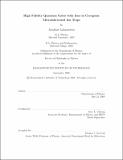High fidelity quantum gates with ions in cryogenic microfabricated ion traps
Author(s)
Labaziewicz, Jarosław
DownloadFull printable version (5.862Mb)
Other Contributors
Massachusetts Institute of Technology. Dept. of Physics.
Advisor
Isaac L. Chuang.
Terms of use
Metadata
Show full item recordAbstract
While quantum information processing offers a tantalizing possibility of a significant speedup in execution of certain algorithms, as well as enabling previously unmanageable simulations of large quantum systems, it remains extremely difficult to realize experimentally. Recently, fundamental building blocks of a quantum computer, including one and two qubit gates, teleportation and error correction, were demonstrated using trapped atomic ions. Scaling to a larger number of qubits requires miniaturization of the ion traps, currently limited by the sharply increasing motional state decoherence at sub-100 [mu]m ion-electrode distances. This thesis explores the source and suppression of this decoherence at cryogenic temperatures, and demonstrates fundamental logic gates in a surface electrode ion trap. Construction of the apparatus requires the development of a number of experimental techniques. Design, numerical simulation and implementation of a surface electrode ion trap is presented. Cryogenic cooling of the trap to near 4 K is accomplished by contact with a bath cryostat. Ions are loaded by ablation or photoionization, both of which are characterized in terms of generated stray fields and heat load. The bulk of new experimental results deals with measurements of electric field noise at the ion's position. Upon cooling to 6 K, the measured rates are suppressed by up to 7 orders of magnitude, more than two orders of magnitude below previously published data for similarly sized traps operated at room temperature. The observed noise depends strongly on fabrication process, which suggests further improvements are possible. The measured dependence of the electric field noise on temperature is inconsistent with published models, and can be explained using a continuous spectrum of activated fluctuators. The fabricated surface electrode traps are used to demonstrate coherent operations and the classical control required for trapped ion quantum computation. The necessary spectral properties of coherent light sources are achieved with a novel design using optical feedback to a triangular, medium finesse, cavity, followed by electronic feedback to an ultra-high finesse reference cavity. (cont.) Single and two qubit operations on a single ion are demonstrated with classical fidelity in excess of 95%. Magnetic field gradient coils built into the trap allow for individual addressing of ions, a prerequisite to scaling to multiple qubits.
Description
Thesis (Ph. D.)--Massachusetts Institute of Technology, Dept. of Physics, 2008. This electronic version was submitted by the student author. The certified thesis is available in the Institute Archives and Special Collections. Includes bibliographical references (p. 135-146).
Date issued
2008Department
Massachusetts Institute of Technology. Department of PhysicsPublisher
Massachusetts Institute of Technology
Keywords
Physics.